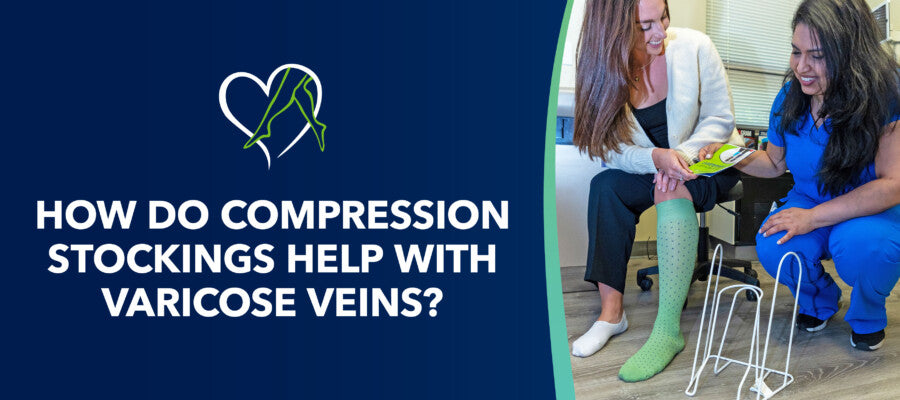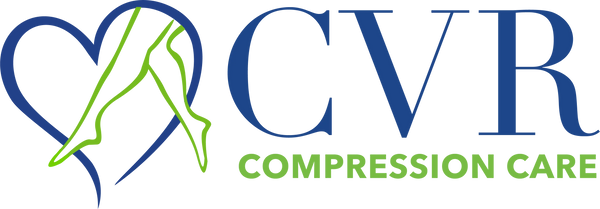
How Do Compression Stockings Help with Varicose Veins?
Share
Varicose veins are enlarged, twisted veins often appear on the legs and can cause a range of uncomfortable symptoms, including pain, swelling, and a heavy, achy feeling. According to the Society for Vascular Surgery, varicose veins affect up to 35 percent of people in the United States.
Thankfully, there are several effective options to manage or prevent varicose veins, with one of the most successful being compression stockings. These elastic stockings have been proven to provide significant relief to those suffering from varicose veins, offering a reassuring solution to those affected by this condition.
What Causes Varicose Veins?
To understand how compression stockings work, it's essential first to understand what causes vein problems such as varicose veins. Leg veins have one-way valves that help push blood back up to your heart against gravity. When these valves become weakened or damaged, blood can pool in the veins instead of flowing correctly. This backed-up blood increases pressure on the vein walls, causing them to swell, twist, and become varicose.
Several risk factors increase your risk for varicose veins, including:
- Family history of varicose veins
- Being overweight or obese
- Pregnancy
- Older age
- Standing or sitting for long periods
What are Compression Stockings?
Compression stockings are specialized garments that apply gentle pressure to the legs, helping to improve blood flow and reduce varicose vein symptoms, including painful bulging veins. They come in a variety of fashionable styles, from knee-high to thigh-high, and are made from stretchy, elastic material that conforms to the shape of the leg.
How Do Compression Stockings Work?
Essentially, compression stockings create a squeeze that mimics and enhances the natural pumping of leg muscles, keeping blood flowing in the right direction.
Compression stockings work by applying graduated pressure to the leg, with the highest pressure at the ankle and gradually decreasing pressure as it moves up the leg. This pressure helps to improve blood flow by assisting the veins in pushing the blood back up to the heart. The elastic material of the stockings also helps the veins maintain their shape, preventing blood from pooling and reducing the symptoms of varicose veins.
- Improve Blood Flow: The pressure from the stockings helps to push blood back up the leg, reducing the pooling of blood in the veins that can lead to varicose veins.
- Reduce Swelling: Compression stockings can help reduce the swelling and inflammation associated with varicose veins by improving blood flow.
- Alleviate Pain and Discomfort: Improved blood flow and reduced swelling can help alleviate the pain, aching, and heaviness that are common symptoms of varicose veins.
The Benefits of Compression Stockings
Numerous studies have shown the benefits of using compression stockings to manage varicose veins. One study reported in Sage Journals found that compression therapy—particularly graduated compression stockings (GCS)—is an effective treatment for relieving varicose vein symptoms and improving quality of life in patients at more severe stages of chronic venous disease (including edema, skin changes, or active or healed leg ulcers).
This study concluded:
- Compression therapy improves CVD-related skin changes, reduces venous leg ulcer-related pain, improves venous leg ulcer healing rates, and reduces the risk of venous ulcer recurrence.
- For patients with active or healed venous ulcers, compression therapy should be offered alongside good wound care and superficial venous intervention as appropriate.
- Compression stockings should be provided immediately after a vein procedure to help reduce pain, edema, and phlebitis. The grade of compression and duration should be individualized based on the patient's characteristics and symptom profile.
- While compression has been shown to be helpful, it is only effective if patients comply with the compression regimen. Poor compliance due to discomfort, difficulty putting stockings on, and itchiness has been widely reported.
An article published by the Cleveland Clinic supports the use of compression stockings by promoting better blood circulation and reducing swelling, which can help with conditions like chronic venous insufficiency and prevent blood clots.
The piece highlights critical benefits, including increased circulation, decreased swelling, prevention of blood pooling, and improved lymphatic drainage. The article also discusses athletes' use of compression socks, noting that they may aid in recovery and subsequent performance.
Choosing the Right Compression Stockings
When choosing the right compression stockings, it's important to work with a healthcare professional, such as a Center for Vein Restoration (CVR) vein care specialist, to ensure that you get the right fit and level of compression. The level of compression is measured in millimeters of mercury (mmHg), with higher numbers indicating a higher level of compression.
For the treatment of varicose veins, compression stockings with a pressure of 20-30 mmHg are typically recommended. Choosing the right size and shape for your legs is vital, as ill-fitting stockings can be uncomfortable and may not provide the desired benefits.
Don't gamble on your vein health by relying on the recommendations of a clerk at the local box store or pharmacy—trust the expertise of a vein care professional who truly understands your individual needs to ensure you get the right compression stockings for effective treatment and relief.
Center for Vein Restoration vein care experts have the knowledge and experience to ensure you get the right compression stockings for your unique needs. From proper sizing to accurate compression levels, we'll guide you every step of the way for effective treatment and relief. Schedule your consultation today and take the first step towards healthier veins and improved quality of life.
Call 240-881-0464 to speak to a Patient Services Representative or schedule your consultation online at a CVR near you today.
How to Use Compression Stockings?
While compression stockings are generally safe and effective, it's wise to talk to your Center for Vein Restoration (CVR) vein specialist doctor before using them, especially if you have certain conditions like diabetes or peripheral artery disease. Most doctors recommend:
- Wearing the stockings daily
- Putting them on first thing in the morning
- Using higher compression levels (20-30 mmHg) for more severe varicose veins
Getting used to wearing compression stockings can take some time and effort. But with a bit of practice, they can provide significant relief from the pain and swelling of varicose veins. Compression stockings, staying active, losing weight if needed, and avoiding long periods of sitting or standing are valuable tools for managing this common condition.
Varicose Veins: Using Compression for Symptom Relief
Compression stockings are a highly effective treatment option for individuals with varicose veins. By improving blood flow and reducing swelling and inflammation, compression stockings can help alleviate the symptoms associated with this condition and prevent the progression of the disease.
If you are experiencing symptoms of varicose veins, it's essential to speak with an experienced vein specialist who can help you determine the best course of treatment, including using compression stockings. With the right fit and level of compression, you can take an important step towards managing your varicose veins and improving your overall quality of life.
Don't rely on guesswork when it comes to managing your varicose veins! Call the vein professionals at 240-881-0464 to speak to a Patient Services Representative or schedule your consultation online at a CVR near you today.
